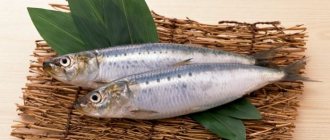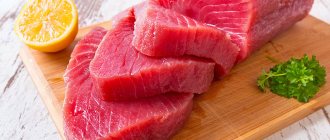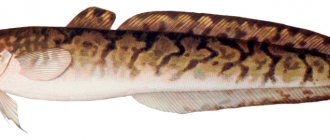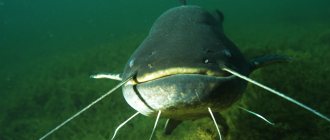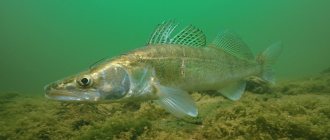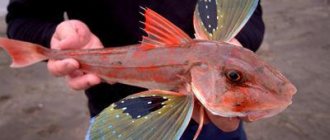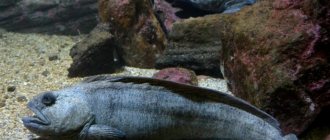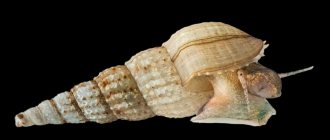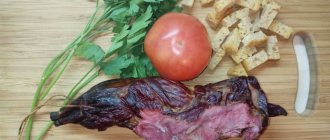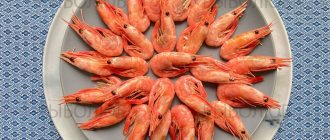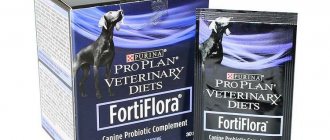- Where does the rudd live?
That's right, the rudd is a real freshwater (albeit small) predator that lives in freshwater rivers and lakes, feeding on various even smaller fish, larvae, worms, etc. The rudd got its name thanks to its red fins, but this
fish also have other names, such as, for example, red-eye, red-winged, red-finned roach, roach, roach, soroga, chernukha and so on. This fish belongs to the class of ray-finned fish, the carp family. Also in the Far East - Sakhalin and near Japan, there is another fish with a similar name - the Far Eastern rudd, and so it has nothing to do with the ordinary rudd, despite the same name, and belongs to a completely different genus of fish.
Description, structure, characteristics
The rudd has a tall body, which is flattened laterally, and a small head. Its teeth are jagged, saw-like and arranged in two rows. The scales of this fish are quite large, even dense. In total, there are 37-44 scales on the sides of the fish. The maximum body length of the rudd reaches 50 cm, but it weighs no more than 2 kg. Although the size and weight of the average rudd is usually much smaller. This is also due to the fact that the rudd is a slow-growing fish (in the first year of life it grows to only 4.5 mm), so that only adult and even old (by fish standards, of course) individuals reach their maximum size and weight.
The rudd has a bright color, its back is dark brown, with a greenish tint, or brownish-green, its belly is silvery, and its sides are golden. The fins, in honor of which our fish got its name, are bright red. Interestingly, the color of young fish is not as bright as that of older fish.
Rudd habitats
The habitats of the rudd are in all fresh rivers and reservoirs of Europe, excluding the northern regions. Also found in Transcaucasia and Central Asia.
The main habitat of fish are the pools:
- Azovsky;
- Black;
- Caspian;
- Baltic and White seas.
Found in rivers of Eastern Siberia. The ideal habitat for rudd is bays, flowing lakes and ponds, oxbow rivers without strong currents. The fish easily tolerates a lack of oxygen and feels protected in turbid water. Selects places where reeds, reeds, duckweed and other plants grow in abundance. Swims near the shores, and at night goes into bottom holes.
Where is it found?
Rudd loves areas of flowing ponds, lakes, and quiet river backwaters overgrown with algae and reeds. Oddly enough, this fish does not like fresh water, nor does it like strong currents, so it is unlikely to be found in fast mountain rivers. She leads a diurnal lifestyle, loves warmth, so in sunny weather she swims at the surface of the water, thus basking in the sun. And when night falls, it swims to the bottom, warmed up during the day, where it buries itself in grass, moss or reeds. And in some ways the rudd’s lifestyle is similar to
bears and other animals that go into hibernation for the winter: the time of greatest activity of this fish is from May to September, but with the onset of winter cold, it lies in holes at depth, and remains there until the end of winter.
In general, the rudd is a calm, unpretentious fish, leading an almost sedentary lifestyle, rarely leaving its native reservoirs. They live in small flocks, and quite peacefully, without conflicting with each other, without dividing territory, as is often the case with other representatives of the animal world. Interesting fact: rudds get along well and can even mate with other representatives of the fish of the carp family: crucian carp, tench, lesha, roach.
How to choose and store correctly
When choosing fresh rudd, you need to pay attention to several points:
- Eye condition. In fresh fish they are light, bright and convex, with a healthy shine. If the rudd's eyes are cloudy, darkened and sunken, the product has already begun to deteriorate.
- Carcass elasticity. When pressing on fresh fish, the indentation from your finger should quickly disappear.
- Appearance. The scales of a quality rudd should be moist, but without mucus. If there are visible stains and damage on the carcass, you should not buy such fish.
- Smell. The fresh product should have the aroma of water and algae. An unpleasant odor indicates spoilage of the rudd.
Assessing the quality of frozen fish is more difficult. In this case, you need to focus on appearance. If ice build-up is present on the rudd, this means that the fish has already thawed at least once and was then re-frozen. You should not buy such a product.
Rudd is stored in the same way as other types of fish. Fresh carcasses can be kept in boxes with finely crushed ice at low temperatures for up to two weeks. It is allowed to put the rudd in the refrigerator at 0-3 °C; first, it must be gutted and washed thoroughly.
The maximum shelf life of rudd in the refrigerator is two days.
Advice! Frozen fish is stored the longest - about three months at a temperature of -18 ° C. The product can be thawed only once, immediately before cooking.
Difference from roach
Very often, our today's heroine, the rudd, is confused with another fish - roach, and for good reason, because they are very similar in appearance. But, nevertheless, there are significant differences between them. Next we will tell you how roach differs from rudd.
In the photo above is a rudd, below is a roach.
What does a rudd look like?
The rudd fish looks much more beautiful than the roach and is also different in that it has completely different pharyngeal teeth, on each side there are 8 teeth arranged in 2 rows and it has an oblique mouth directed upward with a yellow border on the lips. It also has a sharp protruding rib on its belly, this part from the pelvic fins to the anus looks like protruding ribs covered with scales and even smaller and golden scales on the sides of the fish. Another difference between the rudd and the roach is that its dorsal fin begins not above the pelvic fin, like in the roach, but behind it. In addition, the rudd fish is not covered with mucus, like roaches.
In the description of the rudd fish, one can immediately note that it always looks a little thicker and wider than a roach and is more similar in body structure to a bream. Its fins are a much brighter color, its back is brownish-green, the sides of the fish are a brilliant yellow-golden color, and the edges of the scales are edged with a golden-brown border. The eyes are orange with a red spot in the upper half of the eye, and the dorsal fin at the base of the body is blackish and red at the top, the pectoral fins are gray and also reddish towards the tips, all other fins are bright red, even more likely crimson. As can be seen from the description of the rudd, this fish is one of the most beautiful. The colors of large rudd are especially bright during spawning; young fish are much silverier and lighter, their fins are less bright.
Very large rudds over 800 grams have a darker color. Occasionally you come across a special variety of this fish with red scales, called king or prince among fishermen. It is also worth noting that in our reservoirs there are rudd less beautiful than in the reservoirs of Western Europe. In terms of size, this bright and beautiful fish mostly grows up to 24 cm in length and weighs about 400 grams; larger rudds are found quite rarely, and only in exceptional cases can they reach a weight of 1.2 kg. And in some regions, under favorable conditions, it can grow very large, weighing up to 2 kg.
Types, photos and names
The following species are found among rudd.
Rudd Scardinius erythrophthalmus
Scardinius erythrophthalmus is essentially a common rudd, found in many water bodies in Europe, its average length is up to 25 cm, and its weight is up to 400 g. This fish is very popular among amateur fishermen.
Scardinius acarnanicus
Lives in southern Greece. Reaches up to 33 cm in length. It has minor differences from the common rudd in the structure of the fins and the number of gill rakers. Spawning of this species lasts from March to July. This rudd is also endangered.
Greek rudd
Scardinius graecus is also known as the Iliki rudd because it lives in Lake Iliki in central Greece. It is distinguished by its length, which can reach up to 40 cm. And just like Scardinius acarnanicus, it is on the verge of extinction.
Scardinius racovitzai
Lives in the Petzea thermal spring (Baile Epiropesti), in western Romania. This species of rudd is the smallest, its maximum length is no more than 8.5 cm. It is also endangered due to pollution of its habitat.
Fish sizes
Rudd is a slow-growing fish, but despite this, it often reaches quite trophy standards and weight. The length of a large rudd can sometimes be up to half a meter, and such a fish weighs about two kilograms. Most often, such large rudds are caught by spinning anglers, especially in the autumn. But usually fish 15-25 cm long and weighing about 200-400 grams are caught with a fishing rod. Sometimes there is a crazy bite of small rudd on a float rod near the shore. These fish are good to use as live bait. They are strong and tenacious, almost like crucian carp.
Spawning
In the third to fifth year of life, the rudd reaches sexual maturity. The size of the fish by this time is already 12 cm in length, and it is ready for spawning, which lasts from April or May (depending on the habitat) until the end of June at an optimal temperature of 16-20 degrees. By the time of spawning, the color of rudd becomes brighter and more expressive. They lay eggs on aquatic plants, and do not release them all at once, but in measured portions. Before the moment of reproduction, the rudd already matures two portions of eggs, and the third is formed immediately at the moment of spawning. The eggs themselves are sticky, about 1-1.5 mm in diameter. Typically, rudd lays up to 232 thousand eggs, but finding them is not so easy, since they are often attached to the roots of aquatic plants.
The incubation period lasts up to three days. When hatching, their length is 5 mm, and upon reaching 30 mm, the juvenile period begins. Although the number of eggs laid is large, a significant proportion of potential fry die during the incubation period.
Contraindications and possible harm
The freshwater rudd is considered a virtually harmless fish. It is not recommended to use it:
- in case of individual allergy to the product;
- during the period of exacerbation of gastrointestinal ailments.
The fish does not contain substances that can cause harm to health. But this statement is true only for individuals caught in clean waters. Spoiled or parasite-infested fish are still dangerous to humans and can lead to serious poisoning. Only fresh rudd from a trusted supplier that has undergone thorough processing is allowed to be used for culinary purposes.
Interesting Facts
- The significant number of rudd is due to the fact that this fish is very difficult to catch; it is cautious, rarely goes out into open spaces, and when in danger hides in thickets of algae or reeds.
- Rudd did not become a commercial fish, as it tastes somewhat bitter.
- Experienced fishermen know very well that rudd bites exclusively on bright yellow baits; these fish simply ignore baits of other colors. (Now you know the answer to the question: what does the rudd bite on).
- This fish is of interest to sport fishermen due to its wide habitat.
What does the rudd bite on?
Like all carp fish, the rudd is not particularly picky in its diet and its diet includes both plant and animal foods. In fact, the fish is considered a peaceful species, but with age and reaching a mass of over three hundred grams, an individual is not averse to grabbing a fry commensurate with its mouth, which indicates a clear predatory orientation of especially large trophies.
Important! Catching significant trophies with artificial imitations of whitebait, silicone fish, microwobblers, micro-spinning baits and spinners is done using ultra-light spinning tackle.
Otherwise, ordinary-sized fish are taken on common live and plant baits, using their type according to the fishing season.
Important! In cold water, the best results are obtained with animal baits, and in the summer, during the warm water season, they fish for the plant component.
The most promising animal baits include bloodworms, maggots, caddis flies and small dung worms. Insects used for fishing include flies, dragonflies and their larvae, grasshoppers, and all kinds of moths and butterflies. Larger individuals are successfully caught using the cockchafer, especially at the time of its mass emergence. Of the mollusks, zebra mussel meat is used; this is generally the most favorite delicacy of fish in nature, toothless, and small leech sometimes quite successfully maintain the bite.
Of the vegetable baits, canned sweet corn in small grains, boiled pearl barley, and crumbs of white and black bread are especially popular. All kinds of baits based on mixtures of ground vegetable cereals, mastyrka, hominy, and even ordinary dough on water and rye flour with the addition of an attractant attract the fish quite well to the hunting spot. Steamed peas, wheat, oats and barley grains are used during the ripening season of cereals. In mid-May, at the time of rapid growth of green algae, a strand of this substance wound the size of a match head on a hook is also a promising bait for rudd.
Video
And finally, a short video about fishing for rudd.
Author: Pavel Chaika, editor-in-chief of Poznavaika magazine
When writing the article, I tried to make it as interesting, useful and high-quality as possible. I would be grateful for any feedback and constructive criticism in the form of comments on the article. You can also write your wish/question/suggestion to my email [email protected] or Facebook, with respect, the author.
Author page
Useful properties of rudd
Composition and presence of nutrients
Rudd meat is lean, but it is quite rich in a variety of vitamins and minerals, as well as proteins.
This inhabitant of rivers and lakes contains vitamin PP, which is indispensable for protein metabolism and is needed for the release of energy from carbohydrates and fats. It also has a good effect on the cardiovascular and nervous systems, maintains the normal condition of the skin and mucous membranes of the mouth and intestines, and under its influence the functioning of the stomach and pancreas is improved. Of the minerals in rudd, the leading quantitative indicator is fluorine, which plays a major role in the prevention of caries and problems with tooth enamel, potassium, which regulates acid-base and water balance and ensures good physical activity and normal heart function, as well as phosphorus, which is necessary for metabolic processes. In addition, rudd meat contains chlorine, which is needed for digestion and helps cells and tissues get rid of toxins, and sodium, which is involved in the transport of amino acids. Fish contains magnesium, calcium, chromium, nickel, iron and molybdenum in smaller quantities.
Useful and healing properties
The benefits of rudd lie in the vitamins, minerals and acids it contains, and it is not very fatty. Fish contains easily digestible protein, which is important for the functioning of all internal organs.
Rudd helps to establish protein metabolism and provides the body with energy. Eating fish has a positive effect on the functioning of the nervous system, heart and blood vessels. It helps improve the appearance of the mucous membranes and skin. In addition, the functioning of the gastrointestinal tract returns to normal.
It is worth consuming rudd for bone health and preventing dental problems. Thanks to potassium, excess fluid is removed, blood pressure and acid-base balance are normalized. Also, thanks to rudd, you can improve the functioning of the digestive system and cleanse cells of toxins.
Dangerous properties of rudd
You should not use rudd only if you have an individual intolerance.
But it is also very important to select, store and prepare fish correctly in order to protect yourself from parasites that may be contained in fish, as well as from food poisoning caused by stale or improperly prepared product. Have you caught a rudd and don’t know what to cook with it? Try the delicious soup according to Serge Markovich's recipe.
Attention! The information is for informational purposes only and is not intended to make a diagnosis or prescribe treatment. Always consult a specialized doctor!
Tatyana Eliseeva chief editor of the Food+ project
Ask a Question
Rating:
0
/10
Votes: 0
Material usefulness 0
Reliability of information 0
Article design 0
What does the rudd eat?
The rudd fish feeds mainly on plant matter: young shoots of aquatic plants, filamentous algae. A smaller part of its diet consists of insects, larvae, worms, crustaceans, mollusk eggs, fry and eggs of other fish. Young rudd initially eat zooplankton and then switch to plant foods.
Photo by: Klaus Rudloff
Lures
Canned corn - its sweetish smell attracts rudd in the middle and lower layers of water. The tip of the hook is hidden inside the bait, and it is better to completely hide it in the corn grain;
Maggot is a tasty bait in spring and summer days; oddly enough, preference is given to the red-colored species. In the absence of living ones, you can use artificial ones;
A crawler is a large type of worm that can be found in damp soil, near a body of water, mainly at dusk or at night;
Bread crumb is a good way to catch rudd on the surface;
Sweetish dough, painted in bright shades - suitable for fishing in muddy waters, with the addition of drops of attractant, which enhance the aroma of the bait. A good option is to use trout dough, which is placed around the shank of a hook with a spiral, which holds the bait.
Up
Finding a fishing spot
A good place for catching rudd will be lakes, reservoirs, and rivers with a small current, in which there is the presence of dense aquatic vegetation. Rudd can often be seen in warm areas of shallow water, in thickets of hornwort, holly, water lilies, or under a blanket of continuous duckweed.
On clear sunny days, the fish actively feeds and happily grabs the bait in half the water. Due to the structure of the mouth, it picks up insects that have fallen on the surface of the water, being near the shade of trees, reeds and various bushes. Larger specimens are found near algae-covered rocks and among snags.
The main signs when looking for rudd are:
- quite distinct sounds in the form of slurping when feeding;
- river bays, oxbow lakes, upper layers of small reservoirs;
- presence of depths in the region of 1-1.5 m.
- weak current or its complete absence.
Up
